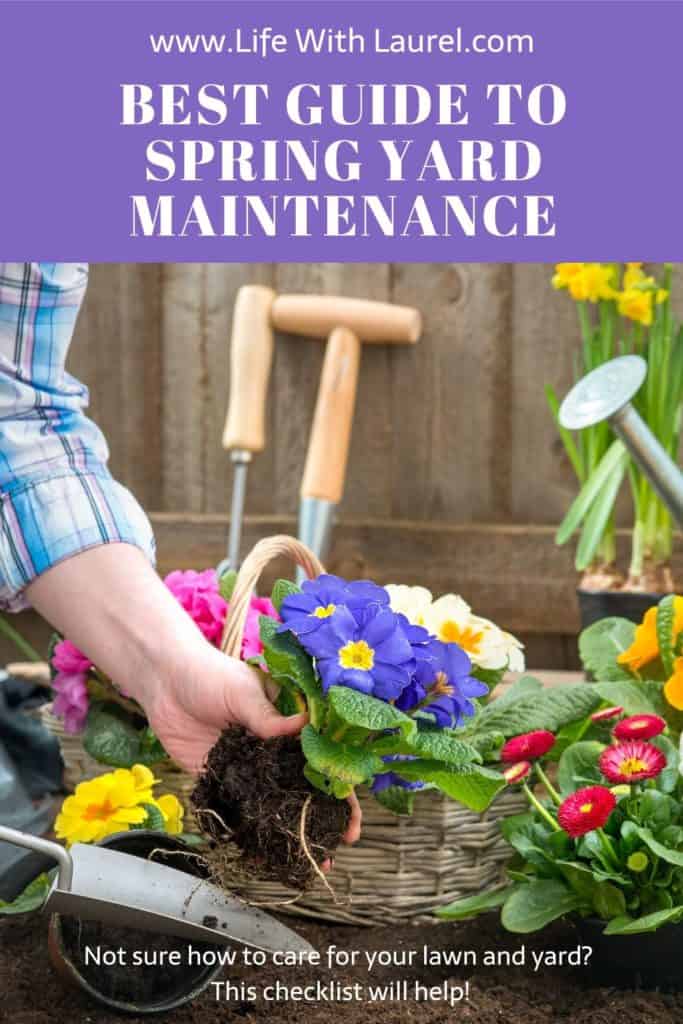Spring Yard Maintenance Checklist|Tips For A Beautiful Yard and Lawn
The sun is starting to warm up and you are anxious to get outside to enjoy your outdoor spaces. Winter has left your grass and shrubs weak after being covered with a blanket of ice and snow for the season. Follow this spring yard maintenance checklist to have a beautiful yard and lawn this summer.
Just as we do spring cleaning to freshen up our home, we need to freshen up our yards by following the spring cleanup tips below. These tips can be divided up into different sections; lawn, yard, and hardscape areas.
Spring Yard Maintenance For the Lawn
1. Rake and Dethatch
Start your Spring cleanup by literally cleaning up the yard. Remove any dog feces and trash that may have blown into the yard in the winter.
Then use an air blower to move the leaves and debris to a central location and follow up with a rake.
Next, you will want to use a tine rake to rake your lawn. A tine rake is a little more sturdy than the traditional leaf rake we are accustomed to. This rake will help remove dead thatch from the turf to encourage new grass growth. Be sure to not rake when the soil is soft and muddy as you run the risk of pulling up healthy grass crowns.
Spring raking removes lingering fall leaves and debris. Raking dead grass ensures the dead blades don’t add to your lawn’s thatch layer and loosens matted grass clumps. Those grass clumps matted from the snow can smother new growth.
2. Overseed
Overseeding is the planting of grass seed onto an existing lawn. It is an easy way to fill holes and brown spots, improves the thickness of the lawn, and enhances your lawn’s color.
While raking, rough up any dead or brown spots to make the lawn ready to overseed. Go ahead and mix your fertilizer with your grass seed in either a hand held or broadcast spreader. Set your settings to the manufacturer’s recommended setting and walk the lawn like you would when mowing the yard.
Once you have seeded you will want to be sure to keep the ground fairly moist until the seed takes root. You can do this by either letting Mother Nature do her job with rain or use an oscillating sprinkler. The power of your sprinkler system may be too much for your tender seeds and seedlings to take root.
3. Aerate
One of the most overlooked tricks to a vibrant lawn is to aerate your lawn. Aeration makes holes in the lawn and loosens the soil underneath. By doing this, you allow water, oxygen and the nutrients penetrate the roots which results in a lush lawn.
You will want to aerate in spring to early summer to have the best effect. Aerating is generally done with a large machine that you can rent at a Home Depot or call a service to do it for you at a reasonable price!
4. Weed
Lawn weeds are a persistent problem as weeds seem to find their way into your beautiful lawn. The top three spring weeds are dandelions, clover, and crabgrass.
You will want to apply a pre-emergent herbicide or use a fertilizer with crabgrass control. Look for an all in one weed and feed. You will want to do this early in the season before the weeds begin to emerge and you don’t want to apply grass seed for a few weeks after you have applied the spring weed and crabgrass control.
Overseeding is best suited for a fall application, but more often than not, needs to be done in the spring as well. You will want to look for a reemergent herbicide called Tenacity. It will not damage the germinating lawn grass seed.
5. Fertilize
As stated above, you may use a combo fertilizer to feed the grass and a pre-emergent herbicide to prevent crabgrass.
You will want to reapply a fertilizer with a broadleaf weed killer 6-8 weeks later.
6. Water
Now is the time to turn on your sprinkler system and do any spring maintenance to the system.
Check your water lines to be sure they are working properly. Adjust your sprinkler heads to be sure the lawn is getting covered in a full cycle. And finally, replace any damaged sprinkler heads.
As a general rule, you should water long enough to moisten the soil down to about 6 inches, which is the depth of a healthy grass-root system. That calculates to about 1″ depending on the soil you have.
To calculate how long to run each zone, put out an empty can in the watering zone and time how long it takes for the can to fill 1 inch deep with water. That is how long you will want to set each zone for.
7. Mow
First things first, make sure your lawn mower is in tip top shape. Have the blades sharpened and serviced to be sure it is running at its optimum condition.
Start mowing when the ground is dry enough and the grass is long enough to require cutting. Mow often and early. You will want to mow every 5 days for the first 6 weeks of spring to ensure a thicker, fuller lawn.
If you let the grass grow too high, it stunts the roots and your lawn cannot reproduce properly.
You also want to be sure to avoid mowing too short as this allows the sunlight to reach the soil and encourages weed seeds to germinate.
Spring Yard Maintenance ForTrees, Shrubs, And Flower Beds
1. Shrubs & Trees
For your trees, you will want to use a hand saw to prune back any winter killed branches. Hire a tree trimmer every 3 years before the leaves come out. It is easier to see the condition of the branches and shape of the tree.
Shrub’s branches can be damaged by the cold, snow, and wind. You will want to prune any winter killed branches to make room for new growth. Prune back to the live stems.
Shape your hedges with hand pruners.
2. Perennials and Ornamental Grasses
Ornamental grasses should be left standing through the winter. Cut them back in spring before the new growth starts. You can use either handheld shears for smaller clumps, or hedge trimmers for larger grasses. You will want to cut down to at least 2-3 inches for smaller grasses and 4-5 inches for larger grasses.
Roses and Climbers- Cut back winter-damaged rose canes to 1″ below the blackened area. For your climbers, keep the younger green canes and remove the older woody ones. Use gentle velcro fasteners or twine to hold the canes in place.
Perennials– Prune flowering perennials to a height of 4-5 inches to allow new growth to shoot up. The the soil has thawed, you may dig up and divide perennials to thin any crowded beds.
3. Beds and Borders
In your beds and borders you will want to clean up around the plants by raking fallen leaves and dead foliage. Be sure to pull up any left over spent annuals.
Push any heaved plants back into your flower beds and borders.
Now is the time to check your irrigation lines and re-fasten with pins that have come loose. Sprinkle a palletized fertilizer to allow the spring rain to saturate and carry the nutrients to the roots. Apply a 5-10-5 fertilizer to bulbs as they flower to maximize the bloom time.
Using a square head shovel around the edges of your beds gives a clean edge and keeps turf grass from growing in them. Plus it gives that professionally landscaped touch!
To really spiff up your beds and borders, mulch them. Not only does it look pretty, it helps slow down evaporation especially when it gets hot outside.

Spring Yard Maintenance For Your Hardscape
1. Paths and Decks
Survey your paths and rake gravel back into aggregate walkways and patios. Fill in with fresh gravel.
Powerwash your decks, patios, and driveway. Oh, you might as well powerwash the garage floor while you’re at it!
Check your wood deck and stain or paint if necessary.
You may want to spruce up your patios and front entrance with a few pots of flowers. Check out this Best Beginners Guide to Container Garden to get started.
2. Fences
Take a walk around your fence to check for any damaged fence posts.
Scrape and paint or repair as necessary.
Final Tips
Now that your yard and lawn is in tip top shape it is time to put the cushions on the patio furniture. Sip some lemonade and admire your efforts.


